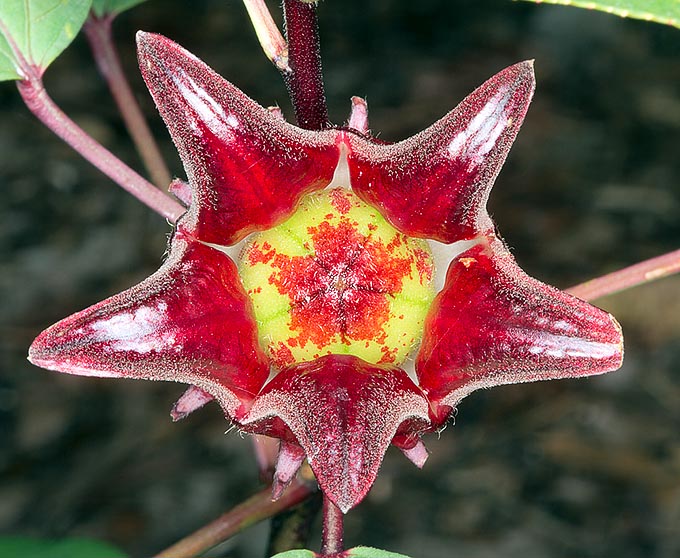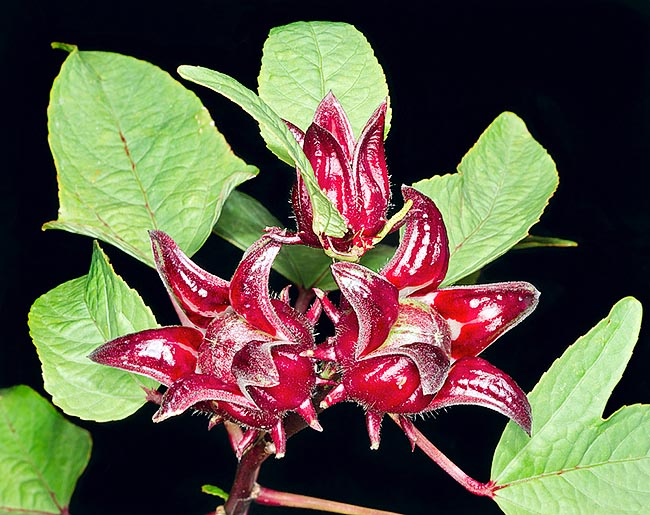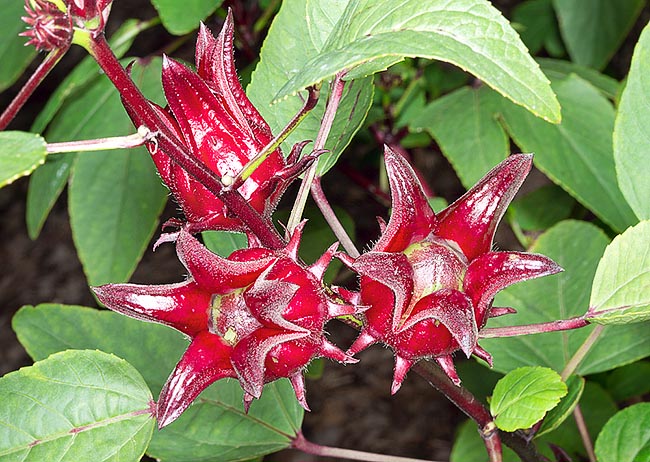Family : Malvaceae

Text © Pietro Puccio

English translation by Mario Beltramini

Hibiscus sabdariffa is an annual or biennial herbaceous species even more than 3 m tall of, it seems, African origin © Giuseppe Mazza
The name of the genus comes from the Latin “hibiscum”, name utilized by Pliny (23-79) to indicate the Althaea officinalis, in its turn derived from the Greek “ibiskos”, referred to some Malvaceae; the specific name comes from a local term used in India.
Common names: Indian-sorrel, Jamaica-sorrel, red-sorrel, roselle, sorrel, sour-sour (English); bissap, Carcadé, Karkadé (Arabic); chukiar (Assamese); chukar (Bengali); mei gui qie, luo shen kui, shan qie zi (Chinese); oseille de Guinée, thé rose d’Abyssinie (French); gongura, lal lambari (Hindi); carcadè (Italian); carurú-de-Guiné, quiabo-azedo, quiabo-de-Angola, quiabo-róseo, quiabo-roxo, rosela, vinagreira (portuguese-Brazil); ambasthaki (Sanskrit); acedera de Guinea, rosa de Jamaica, serení (Spanish); ufuta, ufuta dume (Swahili); Hibiscus-Tee, Malvantee, Rosella (German); erragomgura, gongura (Telegu); kra chiap daeng (Thai); rau chua (Vietnamese).
The Hibiscus sabdariffa L. (1753) is an annual or biennial herbaceous species, up to more than 3 m tall, with little ramified erect stem, usually reddish, glabrous or slightly pubescent. The leaves, on a 1-10 cm long petiole, are alternate, 7-15 cm long, usually ovate in the lower part of the stem, palmate-ovate in the upper one, with three-seven oblong-lanceolate lobes with serrate margins and obtuse apex, 2-8 cm long and 0,5-1,5 cm broad.

The fruits are ovoid capsules about 2,5 cm long and 1,5 cm of diameter. They contain several reniform seeds, dark brown, about 0,5 cm long. Species grown since centuries in the tropics due its alimentary and medicinal properties © Giuseppe Mazza
It is a brevidiurnal species, therefore the blooming begins when the hours of darkness exceed those of light. The fruits are ovoid capsules with pointed apex, about 2,5 cm long and of 1,5 cm of diameter, pubescent, containing several reniform seeds, about 0,5 cm long, of dark brown colour.
It reproduces by seeds, that germinates in 1-3 weeks, in organic draining loam maintained humid at the temperature of 24-26 °C, with beginning of the blooming, in the best cultivation conditions, after about two months.
Species cultivable in the tropical and humid subtropical regions, needs high temperatures, over the 20 °C, lower values slow down the growth up to stopping it around the 15 °C, whilst the death of the plant can occur after some days with temperatures under the 10 °C. It requires an exposition in full sun and is not particular concerning the soil, provided well drained, but prefers the sandy ones rich of organic substance maintained constantly humid, even if it can stand short dry periods thanks to the deep radical apparatus.

All plants parts are edible, but the most used is the calyx containing, besides a high quantity of citric acid, malic and ascorbic acids, pectin, anthocyanins, vitamins and minerals. Is consumed fresh, in salads and soups, as well as dry for preparing various drinks among which the karkadé, the most popular African drink © Giuseppe Mazza
The plant has a vegetative cycle of 6-8 months, therefore can be cultivated also in less favourable climates sowing in protected environment in late winter and transferring the young plants outside when the temperatures allow this. All parts of the plant are edible, but the most utilized is the calyx that contains, besides a high quantity of citric acid, malic and ascorbic acids, pectin and anthocyanins, vitamins and minerals, employed fresh in salads and soups, as well as dry for preparing various drinks among which one much popular in Africa, known as karkadé, consumed warm and also cold with addition of sugar. The calyces, which feed a flourishing trade, are also utilized for syrups, jellies, preserves, cakes and for colouring and aromatizing various dishes.
The leaves and the young buds are consumed either raw or cooked as vegetables and the fermented seeds, that contain proteins, lipids, minerals and vitamins, are employed in Africa as seasoning and for aromatizing various preparations. The resistant fibres gotten from the stem, similar to the jute (Corchorus capsularis L. and Corchorus olitorius L.), from plants selected for this purpose that may reach the height of 5 m, are utilized for fabricating ropes, nets, sacks, etc. Since remote times flowers and leaves, and in lesser extent seeds and roots, are utilized in the traditional medicine of various populations; laboratory studies have evidenced the presence in various parts of the plant, but especially in the calyx, of bioactive compounds with antimicrobic, antitumoral, antioxidant, antihypertensive, hepatoprotective, hypocholesterolemic, anti-inflammatory and anxiolytic activity. Finally, are not to be neglected its ornamental characteristics, as garden plant, and those of the calyces that are employed in the floral compositions.
Synonyms: Hibiscus fraternus L. (1775); Sabdariffa rubra Kostel. (1836); Hibiscus cruentus Bertol. (1840); Abelmoschus cruentus (Bertol.) Walp. (1842); Hibiscus palmatilobus Baill. (1885); Furcaria sabdariffa Ulbr. (1921).
→ To appreciate the biodiversity within the MALVACEAE family please click here.
